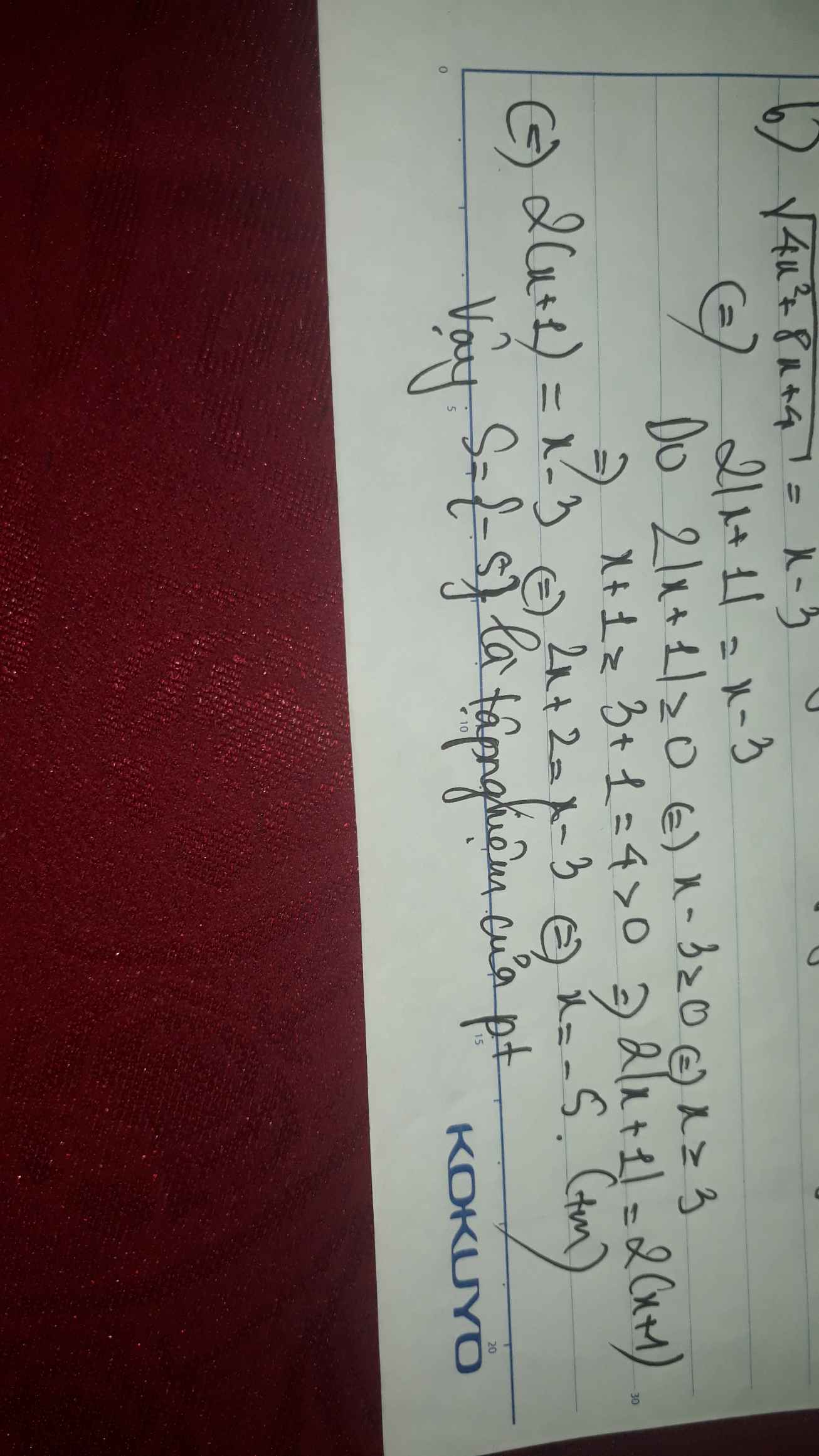Hãy nhập câu hỏi của bạn vào đây, nếu là tài khoản VIP, bạn sẽ được ưu tiên trả lời.

a, ĐKXĐ : \(x\ge\dfrac{1}{2}\)
PT <=> 2x - 1 = 5
<=> x = 3 ( TM )
Vậy ...
b, ĐKXĐ : \(x\ge5\)
PT <=> x - 5 = 9
<=> x = 14 ( TM )
Vậy ...
c, PT <=> \(\left|2x+1\right|=6\)
\(\Leftrightarrow\left[{}\begin{matrix}2x+1=6\\2x+1=-6\end{matrix}\right.\)
\(\Leftrightarrow\left[{}\begin{matrix}x=\dfrac{5}{2}\\x=-\dfrac{7}{2}\end{matrix}\right.\)
Vậy ...
d, PT<=> \(\left|x-3\right|=3-x\)
\(\Leftrightarrow\left[{}\begin{matrix}x-3=x-3\\x-3=3-x\end{matrix}\right.\)
Vậy phương trình có vô số nghiệm với mọi x \(x\le3\)
e, ĐKXĐ : \(-\dfrac{5}{2}\le x\le1\)
PT <=> 2x + 5 = 1 - x
<=> 3x = -4
<=> \(x=-\dfrac{4}{3}\left(TM\right)\)
Vậy ...
f ĐKXĐ : \(\left[{}\begin{matrix}x\le0\\1\le x\le3\end{matrix}\right.\)
PT <=> \(x^2-x=3-x\)
\(\Leftrightarrow x=\pm\sqrt{3}\) ( TM )
Vậy ...
a) \(\sqrt{2x-1}=\sqrt{5}\) (x \(\ge\dfrac{1}{2}\))
<=> 2x - 1 = 5
<=> x = 3 (tmđk)
Vậy S = \(\left\{3\right\}\)
b) \(\sqrt{x-5}=3\) (x\(\ge5\))
<=> x - 5 = 9
<=> x = 4 (ko tmđk)
Vậy x \(\in\varnothing\)
c) \(\sqrt{4x^2+4x+1}=6\) (x \(\in R\))
<=> \(\sqrt{\left(2x+1\right)^2}=6\)
<=> |2x + 1| = 6
<=> \(\left[{}\begin{matrix}\text{2x + 1=6}\\\text{2x + 1}=-6\end{matrix}\right.< =>\left[{}\begin{matrix}x=\dfrac{5}{2}\\x=\dfrac{-7}{2}\end{matrix}\right.\)(tmđk)
Vậy S = \(\left\{\dfrac{5}{2};\dfrac{-7}{2}\right\}\)

1)
ĐKXĐ: x>4
Ta có: \(\dfrac{\sqrt{x+5}}{\sqrt{x-4}}=\dfrac{\sqrt{x-2}}{\sqrt{x+3}}\)
\(\Leftrightarrow x^2+8x+15=x^2-6x+8\)
\(\Leftrightarrow8x+6x=8-15\)
\(\Leftrightarrow14x=-7\)
hay \(x=-\dfrac{1}{2}\)(loại)
2) Ta có: \(\sqrt{4x^2-9}=3\sqrt{2x-3}\)
\(\Leftrightarrow\sqrt{2x-3}\left(\sqrt{2x+3}-3\right)=0\)
\(\Leftrightarrow\left[{}\begin{matrix}2x-3=0\\2x+3=9\end{matrix}\right.\Leftrightarrow\left[{}\begin{matrix}2x=3\\2x=6\end{matrix}\right.\Leftrightarrow\left[{}\begin{matrix}x=\dfrac{3}{2}\\x=3\end{matrix}\right.\)

Câu 4:
Giả sử điều cần chứng minh là đúng
\(\Rightarrow x=y\), thay vào điều kiện ở đề bài, ta được:
\(\sqrt{x+2014}+\sqrt{2015-x}-\sqrt{2014-x}=\sqrt{x+2014}+\sqrt{2015-x}-\sqrt{2014-x}\) (luôn đúng)
Vậy điều cần chứng minh là đúng
2) \(\sqrt{x^2-5x+4}+2\sqrt{x+5}=2\sqrt{x-4}+\sqrt{x^2+4x-5}\)
⇔ \(\sqrt{\left(x-4\right)\left(x-1\right)}-2\sqrt{x-4}+2\sqrt{x+5}-\sqrt{\left(x+5\right)\left(x-1\right)}=0\)
⇔ \(\sqrt{x-4}.\left(\sqrt{x-1}-2\right)-\sqrt{x+5}\left(\sqrt{x-1}-2\right)=0\)
⇔ \(\left(\sqrt{x-4}-\sqrt{x+5}\right)\left(\sqrt{x-1}-2\right)=0\)
⇔ \(\left[{}\begin{matrix}\sqrt{x-4}-\sqrt{x+5}=0\\\sqrt{x-1}-2=0\end{matrix}\right.\)
⇔ \(\left[{}\begin{matrix}\sqrt{x-4}=\sqrt{x+5}\\\sqrt{x-1}=2\end{matrix}\right.\)
⇔ \(\left[{}\begin{matrix}x\in\varnothing\\x=5\end{matrix}\right.\)
⇔ x = 5
Vậy S = {5}

ĐK \(x\ge-3\)
PT <=> \(x^3+5x^2+6x+2=4\sqrt{x+3}+2\sqrt{2x+7}\)
<=> \(2\left(x+3-2\sqrt{x+3}\right)+\left(x+5-2\sqrt{2x+7}\right)+x^3+5x^2+3x-9=0\)
+ Với x=-3 =>thỏa mãn
+Với \(x>-3\) ta liên hợp
\(2.\frac{x^2+2x-3}{x+3+2\sqrt{x+3}}+\frac{x^2+2x-3}{x+5+2\sqrt{2x+7}}+\left(x+3\right)\left(x^2+2x-3\right)=0\)
<=> \(\left(x^2+2x-3\right)\left(\frac{2}{x+3+2\sqrt{x+3}}+\frac{1}{x+5+2\sqrt{2x+7}}+x+3\right)=0\)
Do \(x>-3\)=> \(\frac{2}{x+3+2\sqrt{x+3}}+\frac{1}{x+5+2\sqrt{2x+7}}+x+3>0\)
=> \(x=1\)(TMĐKXĐ)
Vậy \(x=1;x=-3\)

\(a,\Leftrightarrow x^2+2x+1+2x+3-2\sqrt{2x+3}+1=0\\ \Leftrightarrow\left(x+1\right)^2+\left(\sqrt{2x+3}-1\right)^2=0\\ \Leftrightarrow\left\{{}\begin{matrix}x=-1\\2x+3=1\end{matrix}\right.\Leftrightarrow x=-1\left(N\right)\)
\(b,\Leftrightarrow3x^2+3x-2\sqrt{x^2+x}=0\left(x\le-1;x\ge0\right)\\ \Leftrightarrow3x\left(x-1\right)-2\sqrt{x\left(x+1\right)}=0\\ \Leftrightarrow\sqrt{x\left(x+1\right)}\left(3\sqrt{x\left(x-1\right)}-2\right)=0\\ \Leftrightarrow\left[{}\begin{matrix}x\left(x-1\right)=0\\\sqrt{x\left(x-1\right)}=\dfrac{2}{3}\end{matrix}\right.\\ \Leftrightarrow\left[{}\begin{matrix}x=0\\x=1\\x^2-x-\dfrac{4}{9}=0\end{matrix}\right.\\ \Leftrightarrow\left[{}\begin{matrix}x=0\\x=1\\9x^2-9x-4=0\left(1\right)\end{matrix}\right.\)
\(\Delta\left(1\right)=81-4\left(-4\right)\cdot9=225\)
\(\Leftrightarrow\left[{}\begin{matrix}x=0\\x=1\\x=\dfrac{9-15}{18}\\x=\dfrac{9+15}{18}\end{matrix}\right.\Leftrightarrow\left[{}\begin{matrix}x=0\left(N\right)\\x=1\left(N\right)\\x=-\dfrac{1}{3}\left(L\right)\\x=\dfrac{4}{3}\left(N\right)\end{matrix}\right.\Leftrightarrow\left[{}\begin{matrix}x=0\\x=1\\x=\dfrac{4}{3}\end{matrix}\right.\)


ĐKXĐ: \(\left[{}\begin{matrix}x\ge1\\-\dfrac{3}{2}\le x\le-1\end{matrix}\right.\)
\(\left(x^2+2x+1\right)+\left(2x+3-2\sqrt{2x+3}+1\right)+\sqrt{x^2-1}=0\)
\(\Leftrightarrow\left(x+1\right)^2+\left(\sqrt{2x+3}-1\right)^2+\sqrt{x^2-1}=0\)
Do \(\left\{{}\begin{matrix}\left(x+1\right)^2\ge0\\\left(\sqrt{2x+3}-1\right)^2\ge0\\\sqrt{x^2-1}\ge0\end{matrix}\right.\) với mọi x thuộc TXĐ
\(\Rightarrow\) Đẳng thức xảy ra khi và chỉ khi:
\(\left\{{}\begin{matrix}\left(x+1\right)^2=0\\\left(\sqrt{2x+3}-1\right)^2=0\\\sqrt{x^2-1}=0\end{matrix}\right.\) \(\Rightarrow x=-1\)
Vậy pt có nghiệm duy nhất \(x=-1\)